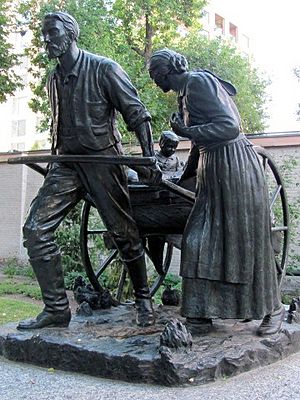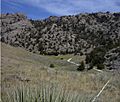Mormon handcart pioneers facts for kids
The Mormon handcart pioneers were a special group of people who traveled to Salt Lake City, Utah, between 1856 and 1860. They were members of The Church of Jesus Christ of Latter-day Saints (often called the LDS Church). Instead of wagons pulled by animals, they used simple handcarts to carry all their belongings across the country.
These pioneers wanted to join other church members in Utah. Many came from countries like England, Wales, Scotland, and Scandinavia. They didn't have enough money for expensive wagons, so handcarts were a cheaper way to make the long journey. About 3,000 people traveled in ten different handcart groups, starting from places like Iowa or Nebraska.
The journey was incredibly tough, especially for two groups that started too late in the year. They got caught in heavy snow and freezing weather in Wyoming. Even with a big rescue effort, more than 210 people from these two groups, out of 980, sadly died. A survivor named John Chislett remembered how hard it was, saying that many fathers pulled their carts, even with their children on them, right up until their last day.
Even though only a small number of Latter-day Saint travelers used handcarts, these pioneers are a very important symbol in their culture. They represent great faith, courage, and sacrifice. Today, they are still honored in events like Pioneer Day and church celebrations.
Contents
What Were Handcarts?
Handcarts were like large two-wheeled carts, similar to big wheelbarrows. They were designed to be pulled by people, not animals. Each family or group would load their food, clothing, and other necessities onto their cart. This meant they could carry only what was absolutely essential for survival.
The idea for handcarts came from Brigham Young, the leader of the LDS Church at the time. He wanted to help more people travel to Utah, even if they were poor. Handcarts were much cheaper than buying wagons and teams of oxen or horses. This allowed many more people to make the journey.
The Journey West: A Difficult Trek
The pioneers faced many challenges on their journey. They walked hundreds of miles across plains, deserts, and mountains. The weather was unpredictable, with hot summers and freezing winters. They often ran out of food and water.
Crossing rivers was also very dangerous. The pioneers had to pull their handcarts through strong currents. Many people got sick, and some died from illness, hunger, or accidents. Despite these hardships, they kept going, driven by their faith and hope for a new life.
The Ill-Fated Companies of 1856
The most famous and tragic handcart journeys happened in 1856. Two companies, led by James G. Willie and Edward Martin, started their trip very late. They left Iowa in July, which was too late to cross the plains before winter.
As they traveled through central Wyoming, early winter storms hit. Heavy snow and freezing temperatures made it almost impossible to move. Many pioneers suffered from frostbite, hunger, and exhaustion. People died every day.
Rescue Efforts and Survival
When news of the struggling companies reached Salt Lake City, Brigham Young organized a massive rescue mission. Teams of wagons loaded with food, clothing, and supplies were sent out immediately. Rescuers found the pioneers starving and freezing.
The rescue teams helped the survivors reach Salt Lake City. This event showed the strong community spirit and willingness to help each other. Even though many lives were lost, the story of the handcart pioneers is also one of incredible human endurance and faith.
Legacy of the Handcart Pioneers
The handcart pioneers are remembered as a symbol of strength and determination. Their story teaches about sacrifice, faith, and working together. Many people today visit the places where they traveled, like Martin's Cove in Wyoming, to remember their journey.
Their legacy is celebrated through monuments, books, and plays. They remind people that with courage and faith, even the hardest challenges can be faced. The handcart journey is a powerful part of American history and the history of the LDS Church.
Images for kids
-
Reenactment: Pioneers crossing the Platte River, from PBS documentary Sweetwater Rescue
-
Dramatization of man pulling handcart through snow
See also
 In Spanish: Pioneros de carros de mano para niños
In Spanish: Pioneros de carros de mano para niños






